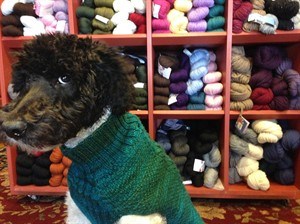
This Tuesday, Dec. 30, 2014 photo shows Toby, a 4-month-old standard poodle, who wears his knitted sweater when he accompanies his owner, Ruthie Kolb, to the Knit Knack shop in Arvada, Colo. When the weather is bitter cold, some of our pets -- especially small dogs with short hair, such as Chihuahuas, pugs and several breeds of terrier -- need to wear a sweater or coat. Find patterns at fabric stores or search online, such as at Pinterest, for do-it-yourself instructions that repurpose sweaters, turtlenecks and T-shirts into warm doggy wear. (AP Photo/Jennifer Forker)
January 06, 2015 - 8:56 AM
It's that time of year when many dogs need a little extra protection — a coat or a sweater — when going out into the cold. Why not try making it yourself?
Small breeds such as Chihuahuas, pugs and Shih Tzus; several kinds of terriers; and some larger, short-haired breeds such as greyhounds and Doberman Pinschers are among those that need to be dressed for winter.
You can buy cold-weather doggy wear, of course. And websites such as Pinterest or Etsy abound with homemade examples, along with other items of clothing for dogs, including dresses, costumes, even blue jeans with suspenders.
There are do-it-yourself instructions online for repurposing sweaters, long-sleeve turtlenecks and T-shirts into warm dog coats and sweaters. Or start from scratch with a pattern and fabric.
Monica Mansfield, a veterinarian in Medway, Massachusetts, recommends using soft fabrics against a dog's skin — fleece works great — and checking any garment bought or made for hard edges or hurtful places. Make sure clothes aren't too snug.
"We can only guess what feels comfortable to dogs," says Mansfield. But "if you run your hands against everything that's touching the dog's skin to make sure there's nothing poking and no prickly thing on it, the vast majority of dogs will accept them and enjoy wearing them."
Short-haired dogs, especially the little ones, probably need to wear their extra coats outside when temperatures dip below 35 or 40 degrees, says the vet.
"All the smaller dogs deserve a sweater," she says.
The ideal garment has wool on the outside and fleece on the inside, she says, for both warmth and comfort.
Karen Vesk of Erie, Pennsylvania, makes dog coats for her two Dobermans — partly to provide warmth but also to allay others' concerns about her two big dogs. "It's fun to dress them up, but also people think of Dobermans as big, tough dogs," says Vesk. "You can't take a dog seriously who's wearing a cupcake sweater."
Vesk makes her dogs' coats because large-breed coats are difficult to find, she says, and are often costly. Her dogs have large chests and small waists, so she adapts out-of-print commercial patterns she finds on eBay (find them new at fabric stores). She uses mostly remnant-table fleece and Velcro closures.
Vesk recommends using a simple poncho pattern with strap and Velcro closure. She measures the dog's chest around, and the length from the neck to the base of the tail.
Toby, a 4-month-old standard poodle, wears an elaborately knitted sweater while greeting customers at the Knit Knack yarn shop in Arvada, Colorado. Fashionable dog knits abound at free online pattern-sharing sites — try Knitty or Ravelry — and in books such as "Top Dog Knits" by Jil Eaton (Breckling Press, 2010).
A knit-store dog needs to wear the wares, says Toby's owner, Ruthie Kolb, who works several days at the shop. "I thought he might need a classy, cabled sweater."
The sweater also comes in handy after Toby's fur is shaved, as it was recently. "When the temperature is minus 1 walking to the shop, as it was this morning, the sweater helps keep him warmer," says Kolb. "He doesn't seem to mind it."
While Vesk's two dogs love the attention they receive while walking in their coats, other dogs may need help becoming accustomed to outerwear.
"Use the old treat method," advises Vesk, "and then they associate putting on their coats with a treat. Eventually, they'll get used to it."
Mansfield advised similarly. "Part of it is training. It's getting them used to it and having a little food reward," she says. "Sometimes at-home love rewards are good."
Do not clothe furry, winter-loving breeds, the vet warns. Dogs such as huskies, malamutes and golden retrievers with thick coats don't need winter wear.
"The way their fur is — they have triple or quadruple thickness — it's like having four coats on already," Mansfield says.
And don't even think about clothing a cat. "I think they'd just be annoyed," says Mansfield.
News from © The Associated Press, 2015